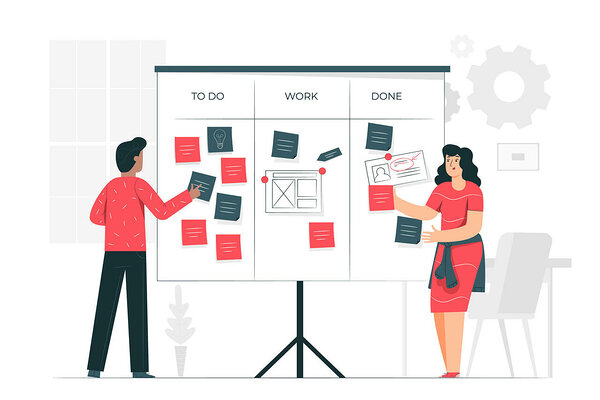March 29, 2022
The project roadmap, a must for your business
Effective project management requires implementing agile scoping methods. Otherwise, lack of visibility and misunderstanding from your hierarchy and your teams will inevitably scuttle your efforts. A project roadmap allows you to plan, monitor and optimize productivity. But, how do you create an effective roadmap? We will share with you everything about this evolving and iterative tool in this article.
An effective project roadmap starts with a good scope
At Ferpection, drawing up a project roadmap is essential for each of our clients and assignments. Every project must benefit a user, whether internal or external. UX research and the creation of a personalized roadmap are closely linked and play a part in quality support and significant time savings.
The context
But first things first, what is a project roadmap?
This is the roadmap for your project. This method, to be implemented as soon as possible, will serve as a guide, retro planning (backward/reverse planning) and a timetable to implement your plan and avoid the pitfalls of chaotic management. Using this tool will help you establish the list of actions to be taken based on a principle of iteration and continuous change. This will allow you to know where you stand with a realistic perspective of the stages of your project.
Creating an effective project protocol starts with scoping it and defining clear objectives. This step, too often neglected, is nevertheless crucial, because it is full of essential elements: it will guide your entire action plan.
If ignored, you may find yourself out of step and wasting valuable time.
The context of the project must therefore be examined: is there a historical link, have attempts been made before, failed, abandoned?
The current environment must also be taken into account: how will you work? Who will make the final decision, how will you communicate the methodological choices, and to whom will you address them?
Scoping includes everything that has to do with defining objectives, and we have to be very clear about that. They will serve as a safeguard and avoid any disruption along the way. It is crucial to acquire full buy-in and communication on your objectives with the whole team (colleagues, management, stakeholders), right from the start.
Proper scoping is an important part of Ferpection's approach:
⏩ find out more about our different support services here.
Performance objectives and indicators
Performance indicators (KPIs) are also too often neglected when creating a project protocol. However, it is vital to take the time to ask yourself which indicators to choose and which objectives to target to ensure that your operation is successful.
This will among other things allow you to:
- manage your time and have a clear vision of the progress of your project
- recognize the resources to be allocated for each step
- estimate the risks involved in the critical phases;
- set up iterative phases in line with the project’s stages.
Defining these precise elements from the outset will give you an idea of the different targets to be reached, without spreading yourself too thin. They will secure all parts of your project, and save you time during the design phase. Note that you will also be more efficient during the implementation period.
“A solid set-up is never a waste of time. It is crucial for any project.”
Mathieu Lombard, Head of UX at Ferpection
Agile methods for project monitoring
Schedule
Now that you have the entire scoping phase of your project in place, you need to follow through and stay on schedule.
Do you have deadlines, imperatives, product constraints, internal synchronizations? It is vital to clarify the schedule from the beginning and review it regularly, i.e., at each phase or at each deliverable. It will therefore be important to keep the scoping sheet up to date to check if you are moving forward in line with the goals and KPIs.
Keeping track of your project roadmap, as well as the milestones depend on the process decided internally: are you going to operate in V-cycle, or in agile method and in this case, are you going to use the sprint or not?
As a reminder, a sprint is based on a short period (one week to one month).
The work to be developed must be prepared in advance and cannot be changed once the sprint has started. Once completed, the work performed is reviewed to determine whether to continue in the same direction or to change course.
The V-cycle is based on the definition, conceptualization, development, and delivery of the project once all its components have been developed.
Agile management, on the other hand, prioritizes requirements, develops and tests them without waiting for the project to grow.
Discover our work methodologies in UX research
Prioritize
Several projects can also be managed simultaneously in your roadmap. In these cases, you need to ask yourself how to manage them together. There is a notion of priority to be put in place relative to objectives, business directions, and backlogs. This means that you can prioritize and, in concrete terms, know how to develop the project chronologically and technically in accordance with the project's expectations.
In terms of tools, all those with a calendar view can be used, including: Notion, Asana, Wrike, Clarizen, z0 Gravity, Monday, etc.
The most important thing is that your tool provides clear visualization and good collaborative information sharing.
How to Create an Effective Project Roadmap | Overview
As we have seen, creating an effective project roadmap hinges on:
- clear contextualization and well-defined working methodologies
- a precise targeting of the objectives and KPIs to be followed
- clarification of your project roadmap, with your deadlines, allocated resources, etc.
- prioritization of your objectives and projects if you undertake several simultaneous developments
- a collaborative tool to follow all the steps and progress of your roadmap, with which you can share information easily
As UX Research specialists, Ferpection can help you understand the expectations and behaviors of your users. Whether on your website, your application, remotely or in person, we help you convert these needs into levers to increase your business through user testing.
If you liked this article, please share it on your social network platforms. You can also subscribe to our newsletter 😉.
All articles from the category: User research | RSS





